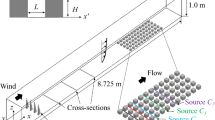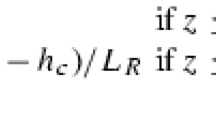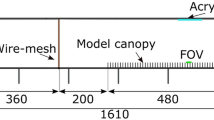Abstract
This paper describes a wind-tunnel experiment on the dispersion of trace heat from an effectively planar source within a model plant canopy, the source height being h s = 0.80 h c , where h c is the canopy height. A sensor assembly consisting of three coplanar hot wires and one cold wire was used to make simultaneous measurements of the temperature and the streamwise and vertical velocity components. It was found that:
-
(i)
The thermal layer consisted of two parts with different length scales, an inner sublayer (scaling with h s and h c ) which quickly reached streamwise equilibrium downstream of the leading edge of the source, and an outer sublayer which was self-preserving with a length scale proportional to the depth of the thermal layer.
-
(ii)
Below 2h c , the vertical eddy diffusivity for heat from the plane source (K HP ) was substantially less than the far-field limit of the corresponding diffusivity for heat from a lateral line source at the same height as the plane source. This shows that dispersion from plane or other distributed sources in canopies is influenced, near the canopy, by turbulence ‘memory’ and must be considered as a superposition of both near-field and far-field processes. Hence, one-dimensional models for scalar transport from distributed sources in canopies are wrong in principle, irrespective of the order of closure.
-
(iii)
In the budgets for temperature variance, and for the vertical and streamwise components of the turbulent heat flux, turbulent transport was a major loss between h s and h c and a principal gain mechanism below h s , as also observed in the budgets for turbulent energy and shear stress.
-
(iv)
Quadrant analysis of the vertical heat flux showed that sweeps and ejections contributed about equal amounts to the heat flux between h s and h c , though among the more intense events, sweeps were dominant. Below h s , almost all the heat was transported by sweeps.
Similar content being viewed by others
References
Antonia, R. A., Danh, H. Q. and Prahbu, A.: 1977, ‘Response of a Turbulent Boundary Layer to a Step Change in Surface heat Flux’, J. Fluid Mech. 80, 153–177.
Batchelor, G. K.: 1949, ‘Diffusion in a Field of Homogeneous Turbulence. I. Eulerian Analysis’, Aust. J. Sci. Res. 2, 437–450.
Coppin, P. A. and Raupach, M. R.: 1986, ‘An Evaluation of Quadrant Analysis of Momentum and Scalar Fluxes Close to Rough Surfaces’, Boundary-Layer Meteorol. (to be submitted).
Deardorff, J. W.: 1978, ‘Closure of Second- and Third-Moment Rate Equations for Diffusion in Homogeneous Turbulence’, Phys. Fluids 21, 525–530.
Denmead, O. T. and Bradley, E. F.: 1985, ‘Flux-Gradient Relationships in a Forest Canopy’, in B. A. Hutchison and B. B. Hicks (eds.) The Forest-Atmosphere Interaction, pp. 421–442, D. Reidel Publishing Co., Dordrecht, The Netherlands.
Finnigan, J. J.: 1979, ‘Turbulence in Waving Wheat. II. Structure of Momentum Transfer’, Boundary-Layer Meteorol. 16, 213–236.
Finnigan, J. J.: 1985, ‘Turbulent Transport in Flexible Plant Canopies’, in B. A. Hutchison and B. B. Hicks (eds.) The Forest-Atmosphere Interaction, pp. 443–480, D. Reidel Publishing Co., Dordrecht, The Netherlands.
Garratt, J. R.: 1980, ‘Surface Influence upon Vertical Profiles in the atmospheric Near-Surface Layer’, Quart. J. Roy. Meteorol. Soc. 106, 803–819.
Kaimal, J. C., Wyngaard, J. C., Izumi, Y., and Coté, O. R.: 1972, ‘Spectral Characteristics of Surface-Layer Turbulence’, Quart. J. Roy. Meteorol. Soc. 98, 563–589.
Legg, B. J., Coppin, P. A., and Raupach, M. R.: 1984, ‘A Three-Hot-Wire Anemometer for Measuring Two Velocity Components in High-Intensity Turbulent Boundary Layers’, J. Phys. E. 17, 970–976.
Legg, B. J., Raupach, M. R., and Coppin, P. A.: 1986, ‘Experiments on Scalar Dispersion within a Plant Canopy, Part III: An Elevated Line Source’, Boundary-Layer Meteorol. (in press).
Lumley, J. L.: 1978, ‘Computational Modeling of Turbulent Flows’, Adv. Appl. Mech. 18, 124–176.
Monin, A. S. and Yaglom, A. M.: 1975, ‘Statistical Fluid Mechanics: Mechanics of Turbulence’, Vol. 2, M.I.T. Press, Cambridge, Mass., U.S.A., Eng. Trans.; J. L. Lumley (ed.) 874 pp.
Monteith, J. L. (ed.): 1975/76, ‘Vegetation and the Atmosphere’, Vols. 1, 2. Academic Press, London. 278 pp., 439 pp.
Panofsky, H. A.: 1974, ‘The Atmospheric Boundary Layer below 150 Metres’, Ann. Rev. Fluid Mech. 6, 147–177.
Raupach, M. R.: 1979, ‘Anomalies in Flux-Gradient Relationships over Forest’, Boundary-Layer Meteorol. 16, 467–486.
Raupach, M. R.: 1981, ‘Conditional Statistics of Reynolds Stress in Rough-Wall and Smooth-Wall Turbulent Boundary Layers’, J. Fluid Mech. 108, 363–382.
Raupach, M. R.: 1986, ‘A Lagrangian Analysis of Scalar Transfer in Vegetation Canopies’, Quart. J. Roy. Meteorol. Soc. (submitted).
Raupach, M. R., Coppin, P. A., and Legg, B. J.: 1986, ‘Experiments on Scalar Dispersion within a Plant Canopy, Part I: The Turbulence Structure’, Boundary-Layer Meteorol. 35, 21–52.
Raupach, M. R. and Legg, B. J.: 1983, ‘Turbulent Dispersion from an Elevated Line Source: Measurements of Wind-Concentration Moments and Budgets’, J. Fluid Mech. 136, 111–137.
Shaw, R. H., Tavangar, J., and Ward, D. P.: 1983, ‘Structure of the Reynolds Stress in a Canopy Layer’, J. Climate and Applied Meteorol. 22, 1922–1931.
Taylor, G. I.: 1921, ‘Diffusion by Continuous Movements’, Proc. London Math. Soc. A20, 196–211.
Thom, A. S., Stewart, J. B., Oliver, H. R., and Gash, J. H. C.: 1975, ‘Comparison of Aerodynamic and Energy Budget Estimates of Fluxes over a Pine Forest’, Quart. J. Roy. Meteorol. Soc. 101, 93–105.
Wilson, J. D., Thurtell, G. W., and Kidd, G. E.: 1981, ‘Numerical Simulation of Particle Trajectories in Inhomogeneous Turbulence, II: Systems with Variable Turbulent Velocity Scale’, Boundary-Layer Meteorol. 21, 423–441.
Author information
Authors and Affiliations
Rights and permissions
About this article
Cite this article
Coppin, P.A., Raupach, M.R. & Legg, B.J. Experiments on scalar dispersion within a model plant canopy part II: An elevated plane source. Boundary-Layer Meteorol 35, 167–191 (1986). https://doi.org/10.1007/BF00117307
Accepted:
Issue Date:
DOI: https://doi.org/10.1007/BF00117307




